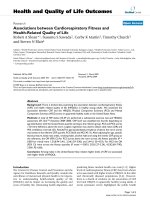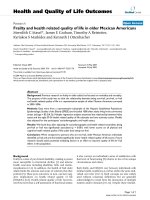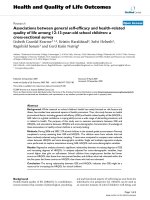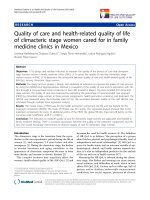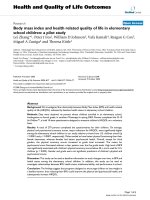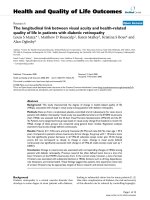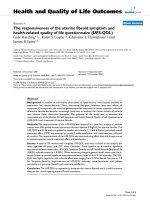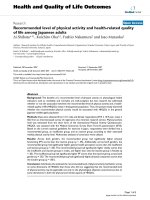Childhood and adolescent asthma a study of perceptions, management and health related quality of life measures
Bạn đang xem bản rút gọn của tài liệu. Xem và tải ngay bản đầy đủ của tài liệu tại đây (1.66 MB, 288 trang )
CHILDHOOD AND ADOLESCENT ASTHMA:
A STUDY OF PERCEPTIONS,
MANAGEMENT AND HEALTH-RELATED
QUALITY OF LIFE MEASURES
CHONG LEE YEE
BSc. Pharm (Hons)
A THESIS SUBMITTED FOR THE DEGREE OF
DOCTOR OF PHILOSOPHY
DEPARTMENT OF PHARMACY
NATIONAL UNIVERSITY OF SINGAPORE
2006
i
ACKNOWLEDGEMENTS
This thesis is people focused. We looked at attitudes and knowledge about asthma and
how asthma had impacted on people’s life. It would be impossible to conduct this
research without the involvement and support of people from all walks of life; from
healthcare professionals, administrators, to members of the public and patients who
shared with us what it means to have asthma. More than 2000 people were involved
directly or indirectly. While it is impossible to name and thank each person here, I take
the opportunity to thank the following people who had played pivotal roles.
I am immensely grateful to A/Prof Li Shu Chuen for supervising my thesis work.
Prof Li showed me the importance of patient-centred approaches and yet at the same
time balances these with proper documentation through outcomes research methods. I
have been gently pushed to be an independent thinker, and feel safe and free to explore
various areas; with the knowledge that Prof Li has been ever watchful, and ready to pull
me back if I head to the wrong direction.
I am very grateful to have A/Prof Chay Oh Moh’s guidance and assistance. She
has great insights, and inspired me with her keen interests in translating research into
clinical practice. Many thanks are also due to Drs. Anne Goh, Jenny Tang and Chiang
WC, Sister Teo Ai Huay, SSN Zaliha, SN Gan, SN Chua, EN Thama, and other staff
members of L and J Clinics of KKH. Their support was crucial in ensuring successful
patient recruitment and smooth running of the projects. SN Chua Lillian had gone out
of her way to help in the focus groups; stayed back late on Saturdays to settle the
logistics, and even gave me free rides home.
ii
The pharmacists of KK Hospital; Miss Tan Ai Lee (pharmacy manager), Tan
Wee Wee and Neo Sheok Been had been instrumental in the earlier projects. The data
from Wee Wee’s honours year project served as a comparator in my projects.
Another group of “assistants” had also generously given me their time and
expertise. Priya Appan did Tamil translations and co-moderated the Tamil focus group.
She also roped in her mother, Dr Shermela Appan, to address the group’s Q & A
session. My thanks also go to the exceptionally motivated and hard working field
interviewers; the NUS Honours year Pharmacy students of year 2003.
The following organisations’ support enabled the projects to be carried out.
Asthma Association of Singapore’s provided a SGD7000 research grant for the focus
group and public survey. NHG Polyclinics allowed us to survey in their premises.
Cheng San RC’s chairman, Mr Salleh referred us asthmatic constituents and generously
allowed us to conduct a focus group session in their meeting room.
I am grateful to the NUS and the Department of Pharmacy for the award of my
research scholarship. My PhD committee; A/Prof Paul Ho and A/Prof Chan Sui Yong
had been very supportive and understanding. Madam Napsiah and Mrs. Teo handled the
administrative issues efficiently for me.
The interaction and friendship with other graduate students provided me with
new perspectives into my own research. I thank Luo Nan for his guidance on HR-QoL
issues, Hwee Lin and Xie Feng for helping in translations.
This thesis is dedicated to my family and my extended family who had been
putting up with the “side-effects” of having a PhD student in the family and my group
of very supportive friends; especially Pooi See.
-iii -
TABLE OF CONTENTS
Acknowledgements i
Table of Contents iii
List of Tables …………………………………………………………………………….ix
List of Figures …………………………………………………………………………xii
Glossary of Abbreviations and Acronyms xiii
Executive Summary xv
Publications…………… xvii
Chapter 1. Introduction 1
1.1 Childhood asthma and management 2
1.1.1 Overview of childhood asthma 2
1.2 Asthma management-parents the important partner 2
1.2.1 Education as the key to improved management 3
1.2.2 Are parents equipped enough? How much do parents know? 3
1.2.3 Could education help? 5
1.2.4 Listening to the patients, parents and caregivers 6
1.2.5 What is the public’s perception of asthma in Singapore? 7
1.3 What is quality of life? 7
1.3.1 Why is it important to measure quality of life? 7
1.3.2 How do we measure quality life? 9
1.3.3 Why can’t we just ask the parents? 10
-iv -
1.3.4 What are the considerations in choosing a quality of life questionnaire?
Are there any differences for children’s and adults? 10
1.3.5 Why and how do you conduct a cross-cultural adaptation and
validation? 11
1.4 Research questions, aims, and thesis organisation 14
Chapter 2. Parents’ knowledge of asthma: A comparison of the Knowledge and
Perception about Asthma between Caregivers from General and
Specialist Clinic at a Paediatric Hospital. 16
2.1 Introduction 17
2.2 Methods 19
2.2.1 Subjects and study settings 19
2.2.2 Procedure 20
2.2.3 The Questionnaire and Scoring 21
2.2.4 Data and Statistical Analysis 21
2.2.5 Inter-rater standardisation 22
2.3 Results 22
2.3.1 Inter-rater standardisation 22
2.3.2 Patient & Caregiver Characteristics 22
2.3.3 Knowledge 26
2.3.3.1 Section A - Parental perception of asthma 26
2.3.3.2 Section B - Knowledge of asthma medications 28
2.3.4 Inhaler Technique 30
2.3.5 Impact of asthma on school 32
2.4 Discussion 33
2.5 Conclusion 36
2.6 Acknowledgements 38
-v -
Chapter 3. Perception of Parents and Patients about asthma, Coping Strategies
and Barriers Encountered in Asthma Management:
A Qualitative Approach to Enhance Understanding 39
3.1 Introduction 40
3.2 Methods 42
3.2.1 Participants and recruitment 42
3.2.2 Inclusion criteria 42
3.2.3 Focus group format 43
3.2.4 Data analysis 48
3.3 Results 48
3.3.1 Patient characteristics 48
3.3.2 General Themes identified across all focus groups 51
3.3.2.1 Perceptions About Asthma 52
3.3.2.2 Management and Coping Strategies 57
3.3.2.3 Barriers of Optimal Management Of Asthma 68
3.3.2.4 Wish List 79
3.3.3 Cultural and sociodemographic differences 81
3.3.4 Patient vs. parental point of views 83
3.4 Discussion 84
3.5 Conclusions 92
3.6 Acknowledgements: 94
Chapter 4. Public perception of asthma: popular beliefs and myths 95
4.1 Introduction 96
4.2 Methods 100
-vi -
4.2.1 Subject characteristics and study design 100
4.2.2 Design of asthma perception questionnaire 102
4.2.3 Data checking and entry 104
4.2.4 Statistical Analysis 104
4.3 Results 106
4.3.1 Subject characteristics and demographics 106
4.3.2 Overall performance for Asthma Perception (AP) and Asthma Treatment
and Management (ATM) Sections 107
4.3.2.1 Influence of socioeconomic and sources of information 115
4.3.2.2 Ethnicity 122
4.3.2.3 Asthma patients vs others 123
4.3.3 Item level analysis 124
4.3.3.1 Areas of good understanding 125
4.3.3.2 Areas of Uncertainty 126
4.3.3.3 Common misconceptions 126
4.3.3.4 Other variables predictive of responses 132
4.3.3.5 Role of ethnicity in the item level 133
4.3.3.6 Asthma patients vs others 164
4.3.4 Sources of Health Information 165
4.4 Discussion 168
4.5 Conclusion 176
4.6 Acknowledgements: 179
-vii -
Chapter 5: Is the Childhood Asthma Questionnaire a good measure of
Health-related Quality of Life of Asthmatic Children in Asia?
Validation of Childhood Asthma Questionnaire (CAQ-B)
Among Asthma Paediatric Patients in Singapore 180
5.1 Introduction 181
5.2 Methods 183
5.2.1 Study Design and Patient Selection 183
5.2.2 Phase I: Questionnaire Selection 184
5.2.3 Cross-cultural adaptation 186
5.2.4 Phase II: Cross-sectional validation 187
5.2.5 Method of analysis 188
5.3 Results 190
5.3.1 Selection of the questionnaire 190
5.3.2 Adaptation of the CAQ-B 191
5.3.3 Cross-sectional validation of CAQ-B (Singapore version) 193
5.3.4 Acceptability of the questionnaire 194
5.3.5 Validity and reliability of CAQ-B (Singapore version) 196
5.3.6 Correlation of Scales with Physician and Parent Reported Severity 198
5.4 Discussion 201
5.5 Conclusions 207
5.6 Acknowledgements 209
-viii -
Chapter 6. Is the Childhood Asthma Questionnaire a good measure of
Health-related Quality of Life of Asthmatic Children in Asia?
Validation of CAQ-C in Singapore 210
6.1 Introduction 211
6.2 Methods 213
6.2.1 Participants 213
6.2.2 Measures 214
6.2.3 Statistical Analysis 216
6.2.4 Analysis of Psychometric properties 217
6.3 Results 219
6.3.1 Demographic and Clinical Characteristics of the Sample 219
6.3.2 Acceptability, completion rates and duration to complete 219
6.3.3 Psychometric Properties 223
6.3.3.1 Construct validity 223
6.3.3.2 Reliability: Internal consistency 223
6.3.3.3 Known group validity 224
6.4 Discussion 228
6.5 Aknowledgements 235
Chapter 7. Conclusions 236
7.1 Study Questions and major findings 237
7.2 Contributions 240
7.3 Limitations 242
7.4 Recommendations for Further research 243
Bibliography…………………………………………………………… …………… 244
-ix -
LIST OF TABLES
Table 2.1: Characteristics of patients investigated in the general paediatric clinic
(GPC) and specialist respiratory clinics (SRC) 24
Table 2.2: Sociodemographics of the caregivers in the general paediatric clinic 25
Table 2.3: Summary of scores obtained in the general paediatric clinic (GPC) and
specialist respiratory clinic (SRC) 26
Table 2.4: Percentage of respondents providing a correct answer for the section
on asthma perception 27
Table 2.5: Percentage of respondents providing a correct answer for the section
on knowledge of asthma medications 29
Table 2.6: Percentages of patients getting each MDI via spacer step correctly,
getting all the critical steps correctly and getting all the critical steps plus gargling
correctly. 31
Table 2.7: Impact of asthma on school attendance: school absenteeism and
conditions that parents would absent children from school 32
Table 3.1: Focus group discussion script 46
Table 3.2: Demographics and characteristics of participating parents and asthma
patients 50
Table 3.3: General themes identified across all focus groups 51
Table 3.4. Recommended things which need to be avoided (restriction) or
exposed/consumed in small quantities (moderation) by asthma patients to avoid
asthma vs. Triggers which had been linked to asthma attacks by parents, or the
patients themselves 62
Table 4.1: Characteristics of respondents to the survey 109
Table 4.2: Breakdown of occupational types of respondents 110
Table 4.3: Mode of administration and language used 110
Table 4.4: Scores of various sections in the survey 114
Table 4.5: Multiple linear regression analysis: effect sizes of demographic factors
influencing perception (AP), asthma treatment and management (ATM) and
overall asthma knowledge (OAK) 118
-x -
Table 4.6: Multiple linear regression analysis: effect sizes of demographic factors
and sources of information influencing perception (AP), asthma treatment and
management (ATM) and overall asthma knowledge (OAK) 119
Table 4.7. Post-hoc test of ANOVA analysis of education level vs. sum of OAK
score 120
Table 4.8: Post-hoc analysis using Mann-Whitney test for education levels 121
Table 4.9: Experience or exposure to asthma patients vs mean percentage scores
in OAK, AP and ATM 123
Table 4.10: Percentages of Correct, Wrong and Unsure answers in the Asthma
Perception Section 129
Table 4.11: Percentages of Correct, Wrong and Unsure answers in the Asthma
Treatment and Management (ATM) Section 131
Table 4.12 Percentages of Correct, Wrong and Unsure answers for other items
related to perception about asthma 132
Table 4.13: Predictor variables and coding used in Item level multinomial
regression analysis 132
Table 4.14 (1)a: Multinomial logistic regression analysis of respondent
characteristics and sources of information as factors for Asthma Perception (AP)
–respondent characteristics 136
Table 4.15 (1a & b): Multinomial logistic regression analysis of respondent
characteristics and sources of information as factors for Asthma Treatment and
Management (ATM) 155
Table 4.16 (1 a & b): Multinomial logistics regression analysis of demographic
and sources of information as factors influencing items related pregnancy and
alternative treatments 162
Table 4.17 (2 a & b): Multinomial logistics regression analysis of demographic
and sources of information as factors influencing items related pregnancy and
alternative treatments 163
Table 4.18: Questions where between asthma patients answered differently 164
Table 4.21: Demographic factors predicting the importance of various sources of
information to respondents 166
Table 5.1: Characteristics of patients involved in the validation of the Childhood
Asthma Questionnaire-B (Singaporean version) 193
-xi -
Table 5.2: Wording in the Childhood Asthma Questionnaire B (Singapore version)
that may require further modifications based on feedback from patients (n = 96)
and parents in the cross-sectional validation 195
Table 5.3 : Phrasing and formatting in the Childhood Asthma Questionnaire B
(Singapore version) that may require further modifications based on feedback
from patients (n = 96) and parents in the cross-sectional validation 196
Table 5.4: A comparison of the internal validity, ceiling and floor effects of
Childhood Asthma Questionnaire-B (Singapore version) before and after (B/A)
the item reduction exercise 197
Table 5.5: Pearson correlation between the domains CAQ-B (Singapore version),
parent-rated severity and physician-rated severity 198
Table 5.6: Comparative scores on subscales of CAQ-B (Singapore version) based
on physician classified clinical severity 200
Table 5.7: Comparison of scores on subscales of Childhood Asthma
Questionnaire-B (Singapore version) based on parent-rated severity 201
Table 6.1: Items which drifted to another domain upon cultural adaptation from
UK to Australia (French et al., 1995; French, 1996). 218
Table 6.2: Participants in the validation exercise 219
Table 6.3: The items in the questionnaire which had missing data 222
Table 6.4: Pre-rotation principal component analysis extracted 13 factors with
Eigen values of more than 1 225
Table 6.5: Varimax rotated component matrix obtained from performing principal
component analysis 226
Table 6.6: A comparison of the internal validity, and study sample between the
UK, Australia and Singapore version (both postulated version and after item
reduction) 227
-xii -
LIST OF FIGURES
Figure 4.1: Histogram of the OAK score (Overall Score) 111
Figure 4.2: Histograms of the Asthma Perception section scores 112
Figure 4.3 Histograms of the Asthma Treatment and Management Scores 113
Figure 4.4: Trends of education level vs. mean sum of Overall Asthma Knowledge (OAK)
115
Figure 5.1 An example of the structure of the CAQ-B questionnaire 192
Figure 6.1: Scree plot of the exploratory factor analysis using principal component
analysis (PCA) 225
-xiii -
GLOSSARY OF ABBREVIATIONS AND ACRONYMS
95% CI - 95% confidence interval
A & E - Accident and emergency department
ADHD - Attention Deficit Hyperactivity Disorder
ANOVA - Analysis of variance
AQoL - Active Quality of Living scale (CAQ-A, B and C Scale)
CAM - Complementary and alternative medicine
CAQ - Childhood Asthma Questionnaire
CAQ-B - Childhood Asthma Questionnaire (version B)
CAQ-C - Childhood Asthma Questionnaire (version C)
DIS - Distress Scale (CAQ-A, B and C Scale)
DPI - Dry powder inhalers
EFA - Exploratory Factor Analysis
FEA - Frequent episodic asthma
FEV1 - Forced Expiratory Volume
FG - Focus groups
GPC - General Paediatric Clinic
HDB - Housing Development Board
HR-QoL - Health-related quality of life
ICC - Intraclass correlation coefficient
ICS - Inhaled corticosteroids
IFEA - Infrequent episodic asthma
KKH - KK Women and Children’s Hospital
KMO - Kaiser-Meyer-Olkin test
LABA - Long acting beta agonists
MCID - Minimal Clinically Important Difference
MDI - Metered-dose inhaler
Mod-PA - Moderate persistent asthma
Mod-SPA - Moderate to severe persistent asthma
MOH - Ministry of Health
MPA - Mild persistent asthma
MRT - Mass Rapid Transit
NAEPP - National Asthma Education and Prevention Program
NASC - National Asthma Shared Care Programme
NHG - National Healthcare Group
PAQLQ - Paediatric Asthma Quality of Life Questionnaire
PCA - Principal Component Analysis
PE - Physical Education
PQoL - Passive Quality of Living scale (CAQ-A, Band C Scale)
QoL - Quality of Life
REACT - Reactivity Scale (CAQ-C Scale)
-xiv -
SABA - Short acting beta agonists
SD - Standard deviation
SEV - Severity Scale (CAQ-A, B and C Scale)
SNAP - Singapore National Asthma Programme
SPA - Severe persistent asthma
SPSS - Statistical Package for the Social Science
SRPC - Specialist Respiratory Clinic
TCM - Traditional Chinese Medicine
TQoL - Teenage Quality of Life Scale
UK - United Kingdom
VAS - Visual analogue scale
VCD - Video Compact Disc
WHO - World Health Organisation
-xv -
EXECUTIVE SUMMARY
In Singapore and many developed countries, asthma is the most common chronic
childhood disease, and exerts significant burden on the children and their caregivers’
physical, emotional and social well-being. Despite the effectiveness of current
pharmacological treatment, it continues to be the one of the main causes of visit to
primary care doctors and utilisation of emergency care and hospitalisation. Therefore, a
more holistic research approach that places the patient and family as the focus is needed
to further understand what other steps are needed to improve the care of asthma.
Effective self-management is crucial factor in ensuring good health outcomes in
asthma. The patients or their caregivers would need to possess sufficient knowledge of
their conditions or treatment plan, and take the appropriate action. Secondly, they must
be willing to adhere to the recommended treatment plans or course of action.
Patients with low health literary are disadvantaged in the first aspect, and need
extra help through patient education. However, for this to be effective, the second
aspect must to be addressed. Education programmes must not only be informative, but
also address aspects existing health beliefs. Therefore, health care providers need to
have a good understanding of patients’ beliefs and management of asthma at home.
In this holistic approach, health-related quality of life measurements are important, as
acts both to inform on areas which need attention, and also as a tool to evaluate the
effectiveness of educational programs holistically.
With this background in mind, the thesis is organised around these objectives:
-xvi -
• First, we wanted to know much parents of asthmatic children know about asthma,
and which are the groups that should be prioritised in patient education.
• Secondly, we wanted to understand how asthma is actually managed at home, and
identify factors or beliefs which contribute or prevent appropriate management.
• Thirdly, we wanted to evaluate the public, or the society’s perception of asthma.
• Lastly, we wanted to measure the impact of asthma in children’s quality of life.
Therefore, we examined the possibility of adapting an instrument developed in a
Western country for patients in Singapore.
In line with these objectives, we made the following findings:
• Firstly, patients cared by non-specialists were often from lower socioeconomic
groups. Their caregivers have poorer understanding of asthma, and the children
had worse health outcomes. This group need to be targeted in asthma education.
• Secondly, asthma has significant impact on the whole family. Food is believed to
cause symptoms (or even the disease), and also the cure. There are many
misconceptions about asthma and steroid inhalers. Therefore, mothers must be
educated, and also supported against the misinformation from others. The concerns
and implication of having asthma differs from the Western studies.
• Thirdly, the public’s understanding of asthma and medication is till relatively poor.
Ethnicity is a factor which affected type of misconceptions harboured.
• Fourthly, the CAQs (Childhood Asthma Questionnaires) have good structure and
easily understood by Singaporean children. However, more work is recommended
to determine its validity in Singapore, which could have been affected by cultural
differences.
-xvii -
PUBLICATIONS
Papers
1. Chong LY, Chay OM, Li SC. Is the Childhood Asthma Questionnaire a Good
Measure of Health-related Quality of Life of Asthmatic Children in Asia?
Validation of Childhood Asthma Questionnaire (CAQ-B) Among Asthma
Paediatric Patients in Singapore. Pharmacoeconomics 2006; 24 (6): 609-621.
2. Chong LY, Chay OM, Li SC. Are We Counselling the Caregivers of Paediatric
Patients Correctly? A Comparison on the Knowledge and Perception about
Asthma between Caregivers from General and Specialist Clinic at a Paediatric
Hospital. [Submitted to Journal of Clinical Pharmacy and Therapeutics]
Abstracts and Conference Proceedings
1. Chong LY, Neo SB, Tan AL, Chay OM, Li SC. A Comparison of Asthma
Knowledge and Medication Compliance between General Clinic and Specialist
Clinic. [Abstract] Proceedings of the 14th Singapore Pharmacy Congress and
9th Pan Pacific Conference, Singapore, 5-9 August 2000. (First prize for podium
presentation)
2. Chong LY, Tan WW, Shih LC, Chay OM, Li SC. Aspects Deserving More
Attention in Educating Caregivers from a General Clinic in Paediatric Asthma.
[Abstract] Proceedings of FIP 61st International Congress, Singapore,
September 1-6, 2001.
3. Chong LY, Chay OM, Goh A, Seng YC Li SC. Cultural Adaptation and
Validation of Childhood Asthma Questionnaire Version B (CAQ-B) for
Singapore Children. [Abstract] International Society for Pharmacoeconomics
and Outcomes Research (ISPOR) 7th Annual International Meeting. Arlington
VA. USA. 19-22 May 2002. Value in Health 2002; 5(3):192.
-xviii -
4. Chong LY, Neo SB, Tan AL, Chay OM, Li SC. Parental Perception of
Childhood Asthma and its Medication. [Abstract] KK Women and Children’s
Hospital 5th Paediatric Scientific Meeting. 19 – 21st September 2002, Singapore.
5. Chong LY, Chay OM, Goh A, Seng YC, Li SC. Cultural Adaptation and
Validation of Childhood Asthma Questionnaire-C (CAQ-C) in Singapore.
[Abstract] International Society for Pharmacoeconomics and Outcomes
Research (ISPOR) 8th Annual International Meeting. Arlington VA. USA. 18-
21 May 2003, 1st ISPOR First Asia Pacific Conference, 1-3 September 2003 in
Kobe, Japan. Value in Health 2003; 6(3): 374-5.
6. Chong LY, Chay OM, Li SC. Correlation between Child-Reported Health
Related Quality Of Life and (HRQL) with Parent and Physician Reported
Severity. International Society for Pharmacoeconomics and Outcomes Research
(ISPOR) First Asia Pacific Conference, 1-3 September 2003 in Kobe, Japan.
7. Chong LY, Li SC, Chay OM, Chua LL, Teo AH, Mohd Yatim Z. What are the
Important Sources of Health Information for Singapore Residents? Proceedings
of the 17th Singapore Pharmacy Congress 1-4 July 2005, Singapore.
Chapter 1: Introduction Chong, Lee Yee
-1 -
Chapter 1. Introduction
Chapter 1: Introduction Chong, Lee Yee
-2 -
1.1 CHILDHOOD ASTHMA AND MANAGEMENT
1.1.1 Overview of childhood asthma
Asthma is the most common chronic childhood illness in Singapore, affecting 1 in 5
children (Wang et al., 2004; Goh et al., 1996; Chew & Lee, 1998) and a significant
burden (Lim et al., 2003). In children less than 15 years old, asthma is second to
accidents and injuries as the principal illness for hospitalisation (Chew et al., 1998). It is
also the second leading condition for visiting a general practitioner and primary health
care clinic for this age group (Chew et al., 1998). Research on how this disease impacts
on children’s quality of life and whether the interventions and treatments provided is
useful would contribute to the management of the disease.
1.2 ASTHMA MANAGEMENT-PARENTS THE IMPORTANT PARTNER
For children, parents are very important partners in the management of asthma. Once
away from the source of care, the burden of care falls onto parents to ensure that the
treatment plans are followed, or the recommendations given by the healthcare provider
(if there are any) gets implemented. Parents, especially the mothers, also play the role
as gate keepers and determine access to healthcare. They would identify the child’s
symptoms, and make decisions on whether a child is sick, needs treatment and what
kind of treatment should be seek.
Whether they have the knowledge to carry out those roles effectively and
whether they believe in doing it are two factors which are crucial to successful
Chapter 1: Introduction Chong, Lee Yee
-3 -
management, and need to be addressed. Studies in the United States among Black and
Navajo patients showed that the barriers to quality asthma care were more dependent on
patients’ beliefs and attitudes rather than access to care issues (Mansour et al., 2000;
Van Sickle & Wright, 2001). The perception of asthma medications could affect their
adherence and ultimately the children’s asthma control and quality of life (Osman,
1997).
Studies also have shown that parents influence their children’s’ coping
strategies, and quality of life. Their own attitudes towards a disease would, therefore,
influence the child’s.
1.2.1 Education as the key to improved management
Among other factors, asthma knowledge is amenable with appropriate education.
Patient education had been given a lot of emphasis in asthma practice guidelines and the
latest National Asthma Education and Prevention Programme (NAEPP) update
identified education for partnership in care as one of the four recommended-as-essential
components of asthma management (Global Initiative for Asthma., 2002; National
Asthma Education Program expert panel report., 1997; National Asthma Education and
Prevention Program., 2002).
1.2.2 Are parents equipped enough? How much do parents know?
Studies on parental or patient knowledge generally found the understanding about the
disease or its management poor, and this could be a hindrance to effective patient-
Chapter 1: Introduction Chong, Lee Yee
-4 -
provider partnership to manage asthma (Shivbalan et al., 2005; Conn et al., 2005;
Belessis et al., 2004). Socioeconomic factors could influence the functional health
literacy, and therefore the asthma knowledge, and patient education is generally
advocated to bridge these gaps.
In Singapore, previous studies which surveyed the knowledge or inhaler
technique of asthma patients generally showed that knowledge is lacking, and the
patients could potentially benefit from patient education efforts (Lim et al., 1996; Tan,
1999; Wong et al., 1994).
Among these, the study conducted at a specialist respiratory clinic of a
tertiary paediatric hospital specifically evaluated the impact of a one-to-one education
intervention on asthma knowledge and outcomes. Asthma knowledge, metered dose
inhaler (MDI) technique, self-reported compliance and symptom scores did improve
significantly after the intervention (Tan, 1999). This highlighted that an educational
intervention can still contribute to improve disease management (Alessandro et al.,
1994) even in specialist clinics that were expected to provide better patient care for
chronic diseases (Sperber et al., 1995; FitzGerald, 2001; Schatz et al., 2005; Vollmer et
al., 1997; Kanter et al., 2002; Wu et al., 2001).
The level of asthma knowledge might be even lower in a non-specialist
setting, as demonstrated by the findings of a 1992 study conducted in government
polyclinics showing the elderly and the less educated had especially poor knowledge
and MDI techniques (Wong et al., 1994). The parents might also have misconceptions
Chapter 1: Introduction Chong, Lee Yee
-5 -
about inhalers which prevented them from complying with the treatment (Lim et al.,
1996).
1.2.3 Could education help?
So far, the consensus is good knowledge itself does not directly translate to positive
attitude and behavioural changes (Ho et al., 2003; Kolbe et al., 1996). Programs which
merely serve to “transfer” information to patients did not seem to be effective (Gibson
et al., 2002). Other intrapersonal factors such as feelings, health beliefs and attitude are
also important (Clark & Starr-Schneidkraut, 1994). In turn, external factors and
resources such as social support, and role models can affect these characteristics (Clark
et al., 1994).
There were mixed results regarding the effectiveness of education as a tool to
improve the outcomes of patients with asthma (Smith et al., 2005). These
inconsistencies have been attributed to factors such as different content, purpose, target
population and intensity of programmes. Some researchers even reported a difference of
education impact between different ethnic groups (Mitchell et al., 1986; Moudgil et al.,
2000). Some studies have pointed out that it generally improved the symptoms, but not
necessary utilization of emergency medical facilities (Smith et al., 2005), while others
concluded that when asthma education and self-management programs improves in
terms of hospitalizations, emergency department attendance, symptoms or quality of life
to various extents (Smith et al., 2005; Choy et al., 1999; Gibson et al., 2003; Chiang et
Chapter 1: Introduction Chong, Lee Yee
-6 -
al., 2005). The effects had also been reported to differ between adults and children
(Moudgil et al., 2000).
One area where asthma education had been shown to be beneficial was
among patients with low functional health literacy (Paasche-Orlow et al., 2005). Low
functional health literacy has been shown to be associated with poorer outcomes and
management skills among patients with chronic diseases like asthma and diabetes
(Williams et al., 1998b; Williams et al., 1998a; Schillinger et al., 2002). However,
patients’ asthma knowledge and self-management skills have been shown to be
variables which could help the barriers cause by poor health literacy and had been
associated with better outcomes and quality of life (Mancuso & Rincon, 2006).
1.2.4 Listening to the patients, parents and caregivers
Patients’ and parents’ knowledge about asthma have been shown to be generally lacking
(Lal et al., 1995; Shivbalan et al., 2005; Zhao et al., 2002). Their perceptions of asthma
may not concur with the asthma pathophysiology and treatment strategies proposed by
health professionals. For example, asthma was still commonly thought to be infectious
by some parents, particularly among studies conducted in the south Indian subcontinent,
and food were identified as the main triggers in Asian countries (Hazir et al., 2002a; Lal
et al., 1995; Shivbalan et al., 2005). Healthcare professionals need to have the cultural
competencies and understand the patient’s perspective of asthma and its treatment in
order to address their concerns and explain the treatment approaches effectively and
arrive in mutually agreed treatment plan which is an important part of concordance.
